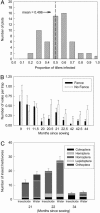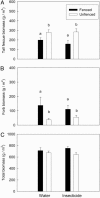Herbivores cause a rapid increase in hereditary symbiosis and alter plant community composition
- PMID: 16116093
- PMCID: PMC1194913
- DOI: 10.1073/pnas.0503059102
Herbivores cause a rapid increase in hereditary symbiosis and alter plant community composition
Abstract
Microbial symbioses are ubiquitous in nature. Hereditary symbionts warrant particular attention because of their direct effects on the evolutionary potential of their hosts. In plants, hereditary fungal endophytes can increase the competitive ability, drought tolerance, and herbivore resistance of their host, although it is unclear whether or how these ecological benefits may alter the dynamics of the endophyte symbiosis over time. Here, we demonstrate that herbivores alter the dynamics of a hereditary symbiont under field conditions. Also, we show that changes in symbiont frequency were accompanied by shifts in the overall structure of the plant community. Replicated 25-m2 plots were enriched with seed of the introduced grass, Lolium arundinaceum at an initial frequency of 50% infection by the systemic, seed-transmitted endophyte Neotyphodium coenophialum. Over 54 months, there was a significantly greater increase in endophyte-infection frequency in the presence of herbivores (30% increase) than where mammalian and insect herbivory were experimentally reduced by fencing and insecticide application (12% increase). Under ambient mammalian herbivory, the above-ground biomass of nonhost plant species was reduced compared with the mammal-exclusion treatment, and plant composition shifted toward greater relative biomass of infected, tall fescue grass. These results demonstrate that herbivores can drive plant-microbe dynamics and, in doing so, modify plant community structure directly and indirectly.
Figures




References
-
- Law, R. & Dieckmann, U. (1998) Proc. R. Soc. London Ser. B 265, 1245–1253.
-
- Dillon, R. J. & Dillon, V. M. (2004) Annu. Rev. Entomol. 49, 71–92. - PubMed
-
- Moore, J. (2002) Parasites and the Behavior of Animals (Oxford Univ. Press, Oxford).
-
- Currie, C. R., Scott, J. A., Summerbell, R. C. & Malloch, D. (2003) Nature 398, 701–704, and correction (2003) 423, 461.
Publication types
MeSH terms
Substances
LinkOut - more resources
Full Text Sources

